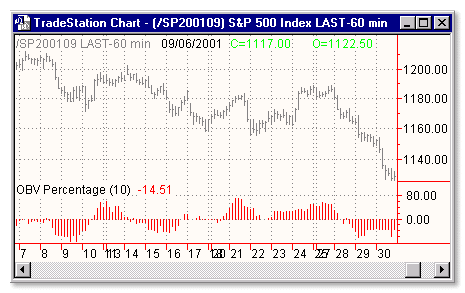Download: obvprcnt.ela
File Includes: Indicator - OBV Percentage
Category: Indicator > Volume Based
Description:
On Balance Volume ("OBV") is a momentum indicator that relates volume to price change. On Balance Volume was developed by Joe Granville and originally presented in his book "New Strategy of Daily Stock Market Timing for Maximum Profits". OBV Percentage indicator plots OBV / Volume percentage.
Indicator shows if volume is flowing into or out of a security. When the security closes higher than the previous close, all of the day's volume is considered up-volume. When the security closes lower than the previous close, all of the day's volume is considered down-volume.
Usage:
The basic assumption, regarding OBV analysis, is that OBV changes precede price changes. The theory is that smart money can be seen flowing into the security by a rising OBV. When the public then moves into the security, both the security and the OBV will surge ahead.
If the security's price movement precedes OBV movement, a "non-confirmation" has occurred. Non-confirma-tions can occur at bull market tops (when the security rises without, or before, the OBV) or at bear market bottoms (when the security falls without, or before, the OBV).
The OBV is in a rising trend when each new peak is higher than the previous peak and each new trough is higher than the previous trough. Likewise, the OBV is in a falling trend when each successive peak is lower than the previous peak and each successive trough is lower than the previous trough. When the OBV is moving sideways and is not making successive highs and lows, it is in a doubtful trend.
Once a trend is established, it remains in force until it is broken. There are two ways in which the OBV trend can be broken. The first occurs when the trend changes from a rising trend to a falling trend, or from a falling trend to a rising trend.

Inputs:
Length - number of bars to consider
EasyLanguage Code:
INPUTS: LENGTH(10);
VARS: OBVT(0), OBVPER(0), FT(0), VT(0) ;
IF CLOSE > CLOSE[1] THEN
OBVT = VOLUME
ELSE IF CLOSE < CLOSE[1] THEN
OBVT = (-1) * VOLUME
ELSE OBVT = 0;
FT = SUMMATION(OBVT , LENGTH);
VT = SUMMATION(VOLUME , LENGTH);
IF VT <> 0 THEN
OBVPER = (FT / VT) * 100 ;
PLOT1(OBVPER, "OBV%");